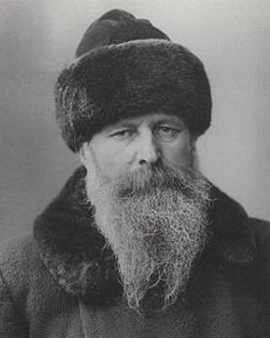"I've loved the sun all my life. I wanted to paint the sunshine. But the war haunted me." This statement by Vasili Vasilievich Vereshchagin describes a dichotomy that marked the life of the artist. Vereshchagin came from the Russian landed gentry and started a military career at the age of eight. As a cadet in the Russian Navy he travelled through Western Europe and also got to know the Middle East. After graduating from the Naval Academy, however, he left military service to become a painter. The military and war was one of the constants in his life, the other was his passion for travelling. In the following years he travelled Europe, India, the Middle East, the Asian part of Russia and the Himalayan region.
Although he periodically returned to Russian military service, and served as an officer in the tsarist army during the Russian-Turkish war of 1877/78, for example, the horror of the war did not leave him and became his main artistic subject. Just as the military never quite let go of him, Vereshchagin always returned to Russia, although he followed the path of many Russian intellectuals to Western Europe. For many years Munich was the centre of his life, where he maintained a studio. His relentless war paintings, which depicted the suffering and violence of war, caused a sensation. Vereshchagin developed a photorealistic style that provoked fierce reactions among his contemporaries. His orientation towards the new medium of photography caused irritations. Again and again his documentary style was criticized.
Vereshchagin was a political artist who pursued a clear didactic goal through his paintings. By depicting the horrors of war, he wanted to popularize his belief in the necessity of peace. With his artistic mission, he encountered a deeply divided culture at the end of the 19th century, which was imperialist in the mainstream, but which also produced strong pacifist movements as a counter impulse. One of his major works, the "Apotheosis of War", had such an effect on the German Chief of General Staff Helmuth von Moltke during a visit to an exhibition in Munich that the military left the exhibition speechless and immediately prohibited German soldiers from visiting the exhibition. The effect was quite intended, Vereshchagin dedicated his painting to all conquerors of the past, present and future. In Russia his pictures of the war were not allowed to be shown in public and also not to be printed in books. The depiction of a shooting scene in a British colonial war in India led to fierce reactions in the British public.
×





.jpg)
.jpg)
.jpg)
.jpg)
.jpg)
.jpg)
.jpg)
.jpg)
.jpg)
.jpg)
.jpg)
.jpg)
.jpg)
.jpg)
.jpg)
.jpg)
.jpg)
.jpg)
.jpg)
.jpg)
.jpg)
.jpg)
_La_tombe_royale_de_Juda_(In_Jerusalem_The_Royal_Tomb_Of_Jud_-_(MeisterDrucke-1323457).jpg)
_La_tombe_royale_de_Juda_(In_Jerusalem_The_Royal_Tomb_Of_Jud_-_(MeisterDrucke-1323457).jpg)
.jpg)
.jpg)
_(Apres_le_siege_de_Pleven_(Plevna)_-_(MeisterDrucke-1318385).jpg)
_(Apres_le_siege_de_Pleven_(Plevna)_-_(MeisterDrucke-1318385).jpg)
.jpg)
.jpg)
_-_Peinture_de_Vasili_Vasilye_-_(MeisterDrucke-1423103).jpg)
_-_Peinture_de_Vasili_Vasilye_-_(MeisterDrucke-1423103).jpg)
.jpg)
.jpg)
_-_Peinture_de_Vasili_Petrovich_Vereshchag_-_(MeisterDrucke-1340393).jpg)
_-_Peinture_de_Vasili_Petrovich_Vereshchag_-_(MeisterDrucke-1340393).jpg)
.jpg)
.jpg)
.jpg)
.jpg)
_(A_Horseman_in_Samarkand)_-_Peinture_de_V_-_(MeisterDrucke-1318548).jpg)
_(A_Horseman_in_Samarkand)_-_Peinture_de_V_-_(MeisterDrucke-1318548).jpg)
.jpg)
.jpg)
.jpg)
.jpg)
.jpg)
.jpg)
.jpg)
.jpg)
.jpg)
.jpg)
.jpg)
.jpg)
.jpg)
.jpg)
.jpg)
.jpg)
.jpg)
.jpg)
_dAvout_dit_Davout_(1770-1823)_dans_le_-_(MeisterDrucke-1314035).jpg)
_dAvout_dit_Davout_(1770-1823)_dans_le_-_(MeisterDrucke-1314035).jpg)
.jpg)
.jpg)
.jpg)
.jpg)
.jpg)
.jpg)
.jpg)
.jpg)
.jpg)
.jpg)
.jpg)
.jpg)
.jpg)
.jpg)
.jpg)
.jpg)
.jpg)
.jpg)
.jpg)
.jpg)
.jpg)
.jpg)
.jpg)
.jpg)
.jpg)
.jpg)
.jpg)
.jpg)
.jpg)
.jpg)
.jpg)
.jpg)
.jpg)
.jpg)
.jpg)
.jpg)
.jpg)
.jpg)
.jpg)
.jpg)
_sur_la_place_du_Registan_a_Samarcande_(_-_(MeisterDrucke-1313455).jpg)
_sur_la_place_du_Registan_a_Samarcande_(_-_(MeisterDrucke-1313455).jpg)
.jpg)
.jpg)
_(Conquete_du_Turkestan_par_la_Russie_im_-_(MeisterDrucke-1320204).jpg)
_(Conquete_du_Turkestan_par_la_Russie_im_-_(MeisterDrucke-1320204).jpg)
.jpg)
.jpg)
.jpg)
.jpg)
.jpg)
.jpg)
_-_(MeisterDrucke-899884).jpg)
_-_(MeisterDrucke-899884).jpg)
_a_Samarcande_(Ouzbekistan)_(Necropolis_-_(MeisterDrucke-1313895).jpg)
_a_Samarcande_(Ouzbekistan)_(Necropolis_-_(MeisterDrucke-1313895).jpg)
.jpg)
.jpg)
.jpg)
.jpg)
_-_Peinture_de_Vasili_Vasilyevich_Vereshch_-_(MeisterDrucke-1323256).jpg)
_-_Peinture_de_Vasili_Vasilyevich_Vereshch_-_(MeisterDrucke-1323256).jpg)
_-_(MeisterDrucke-1503656).jpg)
_-_(MeisterDrucke-1503656).jpg)
_sur_le_lac_a_Udaipur_(Rajasthan_at_the_Lake_in_Udaipur)_-_Peint_-_(MeisterDrucke-1314338).jpg)
_sur_le_lac_a_Udaipur_(Rajasthan_at_the_Lake_in_Udaipur)_-_Peint_-_(MeisterDrucke-1314338).jpg)
_-_Peinture_de_Vasili_Vasilyevich_Vereshchagin_(Vassili_Verech_-_(MeisterDrucke-1324883).jpg)
_-_Peinture_de_Vasili_Vasilyevich_Vereshchagin_(Vassili_Verech_-_(MeisterDrucke-1324883).jpg)
.jpg)
.jpg)
.jpg)
.jpg)
_(A_Chinese_Temple_Ruin_in_Akkent)_-_-_(MeisterDrucke-1325507).jpg)
_(A_Chinese_Temple_Ruin_in_Akkent)_-_-_(MeisterDrucke-1325507).jpg)
_-_(MeisterDrucke-1634980).jpg)
_-_(MeisterDrucke-1634980).jpg)
_(Deux_guerriers_postes_a_la_port_-_(MeisterDrucke-1323574).jpg)
_(Deux_guerriers_postes_a_la_port_-_(MeisterDrucke-1323574).jpg)
 - (MeisterDrucke-678694).jpg)
 - (MeisterDrucke-678694).jpg)
.jpg)
.jpg)
.jpg)
.jpg)
_-_(MeisterDrucke-1637378).jpg)
_-_(MeisterDrucke-1637378).jpg)
.jpg)
.jpg)
_(Dervishes_-_(MeisterDrucke-1325551).jpg)
_(Dervishes_-_(MeisterDrucke-1325551).jpg)
.jpg)
.jpg)
.jpg)
.jpg)
.jpg)
.jpg)
.jpg)
.jpg)
_-_Peintur_-_(MeisterDrucke-1317928).jpg)
_-_Peintur_-_(MeisterDrucke-1317928).jpg)
.jpg)
.jpg)
.jpg)
.jpg)
_-_(MeisterDrucke-1637380).jpg)
_-_(MeisterDrucke-1637380).jpg)
_-_(MeisterDrucke-1629198).jpg)
_-_(MeisterDrucke-1629198).jpg)
.jpg)
.jpg)
.jpg)
.jpg)
_(Vehicle_of_a_Rich_Family_in_Delh_-_(MeisterDrucke-1320206).jpg)
_(Vehicle_of_a_Rich_Family_in_Delh_-_(MeisterDrucke-1320206).jpg)
.jpg)
.jpg)
_-_(MeisterDrucke-903352).jpg)
_-_(MeisterDrucke-903352).jpg)
.jpg)
.jpg)
.jpg)
.jpg)
.jpg)
.jpg)
.jpg)
.jpg)
.jpg)
.jpg)
.jpg)
.jpg)
.jpg)
.jpg)
_-_Peinture_de_Vasili_Vasilyevich_Vereshchagin_(Vassili_Ver_-_(MeisterDrucke-1325681).jpg)
_-_Peinture_de_Vasili_Vasilyevich_Vereshchagin_(Vassili_Ver_-_(MeisterDrucke-1325681).jpg)
.jpg)
.jpg)
.jpg)
.jpg)






